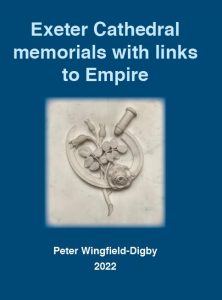On 10 November we met for lunch at The Stables, our new regular venue near Cowley Bridge. After lunch we adjusted curtains, lights, chairs and screen in preparation for the illustrated talk from our Secretary, Peter Wingfield-Digby. Peter explained that much of his research on this topic had been carried out during the enforced period of Covid lockdown, when he was unable to continue as a volunteer guide at the cathedral.
Peter gave everyone a handout with a plan showing where each memorial is located in the cathedral. Some memorials are on the wall, others (ledger stones) are in the floor and remarkably, 63 have links with the old British Empire, commemorating the lives of soldiers, sailors, missionaries, explorers and their families, as well as others including employees of the East India Company and plantation owners in overseas colonies producing sugar and tobacco.
We were amazed at the stories that lay behind some of these memorials. One records the death of Arthur Corfe Angel, officer on the steamship ‘London’ that foundered in Bay of Biscay storms in 1866 on its way to Melbourne. Arthur was the son of the cathedral organist. He was ‘seen by the survivors with his hand still upon the engine of which he was in charge, calmly awaiting death when the waters closed over the ship’. Another memorial records the death ‘of a fever’ in 1895 of George Knight-Bruce, a Devonian who had served as Bishop of Bloemfontein in South Africa before becoming the first Bishop of nearby Mashonaland. Not all the memorials record the lives of men: one rather poignantly notes the death of Rachel O’Brien, wife of army captain E J O’Brien while he was stationed in Exeter, due to severe burns after her clothes caught fire as she was playing with her baby – unfortunately, too close to the fireside. She was only 19.
While half of the memorials are dedicated to those who had served in the armed forces, one very impressive memorial in the south transept has nothing to indicate whose lives it commemorates. In fact it honours Sir John Gilbert and his wife Elizabeth Chudleigh. Sir John was High Sheriff of Devon in 1572. The squirrel at his feet is not only the crest of the Gilbert family but is also the name of the ship that carried his brother Sir Humphrey Gilbert across the Atlantic in 1583. He landed at St John’s, and claimed Newfoundland for the crown. This was the first British overseas colony.
There are many other fascinating and well-researched accounts recorded in a compact book that Peter has recently published, entitled ‘Exeter Cathedral memorials with links to Empire’. Unsurprisingly he sold out all the copies he had with him, in minutes! Our thanks to Peter for an excellent talk, given at short notice in place of our scheduled speaker. Please do contact Peter direct if you would like a copy of his book.
Louise Clunies-Ross

